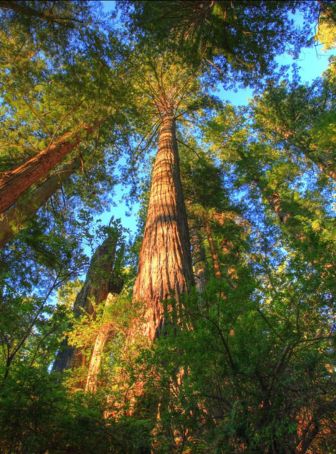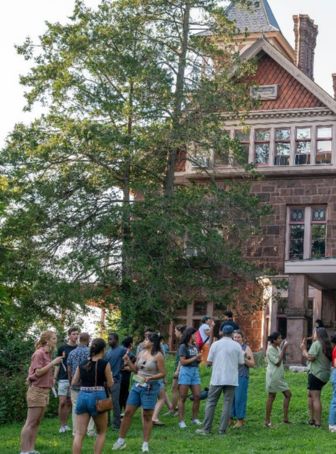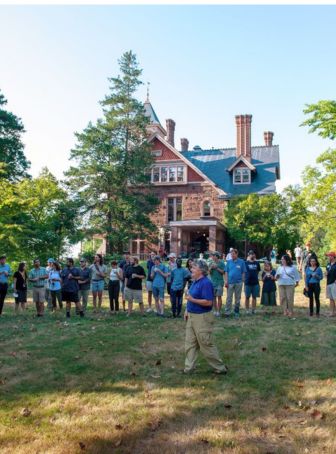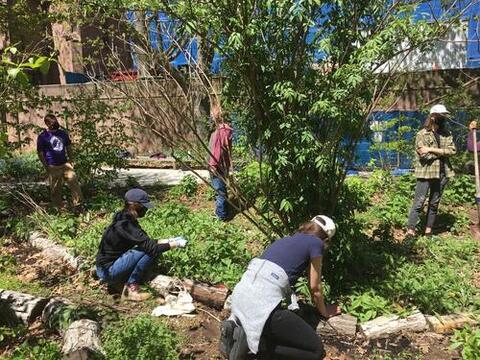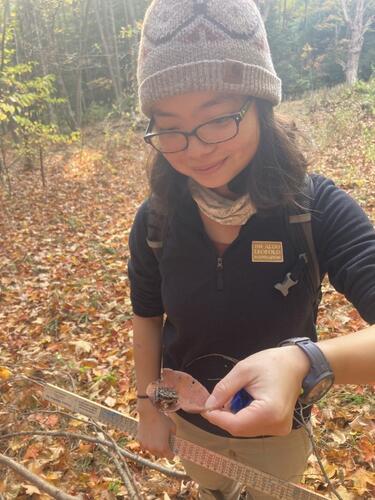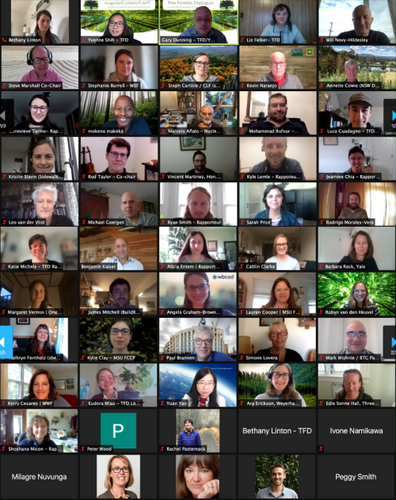The Overstory
Welcome to The Overstory, the tri-annual publication of forest-centric news produced by The Forest School at the Yale School of the Environment. We are excited to share with you how our community is advancing the field of forestry in all its many forms.
Featured Article: Forestry at Yale and SAF: A Shared Foundation and Vision
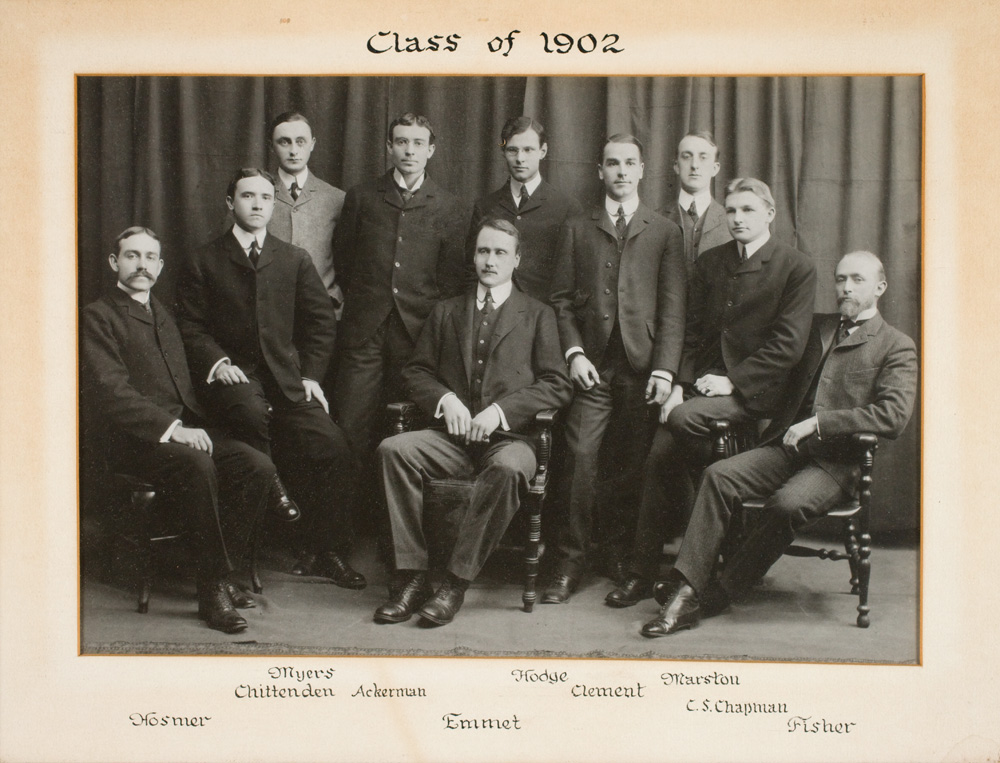
By: Sara Santiago ’19 MF
This story appears in the September 2025 Vol. 30 No. 9 (link is external) issue of the Society of American Foresters’ The Forestry Source.
This year, we are celebrating not just the 125th anniversary of the Society of American Foresters but also The Yale Forest School (now known as the Yale School of the Environment)—and how these two institutions have grown side by side and shaped the profession of forestry in the United States.
Since the late 1800s, our origins have been connected. At this time, the profession of Western scientific forestry began rooting in North America through European-trained foresters, including Gifford Pinchot, the forester for the Biltmore Estate, which was the first professionally managed forest in the U.S.
Pinchot, his family, and Henry S. Graves provided the founding gifts to establish The Yale Forest School (the School) just two years after Pinchot started at Biltmore in 1900. The School was dedicated to training professional foresters to manage forests across the United States, and Pinchot strove to create high standards for educating foresters and for the new profession itself.
To elevate the profession, Pinchot invited seven professional foresters, including Graves, to form the Society of American Foresters on November 30, 1900, with the objective to foster comradery among foresters, create a free exchange of ideas, and disseminate knowledge in forestry. The Yale Forest School set out to develop approaches to the practice of forestry, generate knowledge about forests, and promote the values they bring to people’s livelihoods and the well-being of society.
A Timeline of Defining American Forestry
From the beginning, The Yale Forest School and the Society of American Foresters (SAF) have been concerned with the conservation of U.S. forests after broadscale colonial clearance, in educating high-caliber professional foresters, and defining the profession itself.
And those early years were busy. The Yale Forest School started its first summer forest apprenticeships for incoming students at Grey Tower, the Pinchot family estate, in 1901, acquired the first of seven forests to make up the Yale Forests system in 1908, and welcomed its first international students in the 1910s. With President Theodore Roosevelt’s creation of the USDA Forest Service, The Yale Forest School graduated the agency’s first four chiefs (Pinchot served as its first chief overseeing the national forest system). The School went on to define forest ecology and silviculture through experiments at Hubbard Brook and throughout the Northeast.
Concurrently, SAF established its first periodical, Proceedings of the Society of American Foresters, in 1905 and held its first national conference the same year with a focus on formulating a standard forestry curriculum. The first chapter was established in Missoula, Montana in 1912, and SAF annual meetings branched out of Washington D.C., in 1915. In 1920, SAF held its Second National Conference on Forestry Education, which led to a study of forestry schools, and Pinchot chaired an SAF report recommending federal regulation of private forests. In 1935, SAF began its forestry school accreditation, and The Yale Forest School was amongst that first group of accredited schools.

The Yale School of the Environment graduates a large, vibrant cohort of foresters and environmentalists in its 125th year. Photo: Yale School of the Environment
Modern Forestry
What was it like after Gifford Pichot, a forester so prominent in the histories of The Yale Forest School, SAF, and the US Forest Service? After those early decades of creating structure, organizing, influencing national policy, forming chapters, and graduating professional foresters, both SAF and now the Yale School of the Environment have opened up and broadened out, inviting professionals from various backgrounds, creating programming, and generating new science.
SAF has established local and regional chapters across the U.S. It currently accredits 68 colleges and universities. SAF continues to build comradery in the profession by holding its annual convention in new locations across the country, while regional and local meetings are recurring. SAF’s programming has blossomed to include certifying and licensing foresters; offering continuing education opportunities; producing advocacy statements and priorities; numerous committees; and honoring young professionals, diversity scholars, and retirees.
The Yale School of the Environment, with The Forest School as a sub-school within it, has broadened into a larger environment school that maintains forestry at its core and ethos. The Forest School at the Yale School of the Environment’s scope is not only domestic but international, not only rural but urban, working on topics such as forest ecology and silviculture, forest restoration, community forestry, pests and pathogens, watershed health, agroforestry, and forest carbon. Our foresters are concerned with fuel load reduction rather than fire suppression, landback rather than dispossession, and community-driven forestry rather than top-down implementation. Central to The Forest School’s teaching, research, and practice is people- and place-based approaches.
Celebrating at National Convention
To mark 125 years of growth, the SAF National Convention will be held October 22 to 25, 2025, in Hartford, Connecticut, just up the road from The Forest School at the Yale School of the Environment, where we will celebrate our alumni reunion weekend as SAF’s convention closes.
At SAF National Convention, we will explore our shared legacies and our current realities and objectives. We will consider the past as well as the call of our vocation now, given both challenges and invitations to continue growing. Convention will be organized into three core themes to explore this:
- Roots: Foundations of Modern Forestry. We will reflect on the early days of scientific forestry, including key philosophies, institutions, and practices.
- Trunk: Growth of Sustainable Practices. We will focus on the growth and maturation of sustainable forestry practices from technology to policy.
- Canopy: Future of Forest Stewardship. We will look toward the future and discuss emerging trends, challenges, and opportunities.
We invite you to join us.
Sara Santiago is assistant director at The Forest School at the Yale School of the Environment and serves on the SAF National Convention Planning Committee.
References
“History.” 2020. Yale.edu. 2020. https://environment.yale.edu/forest-school/about/history (link is external).
“History.” 2021. Eforester.org. 2021. https://www.eforester.org/Main/About/History/Main/About/History.aspx (link is external)
“Our Charter Members.” n.d. Accessed July 10, 2025. https://foresthistory.org/wpcontent/uploads/2024/08/SAF-Charter-Members-1940-profile.pdf (link is external)
Notch, Crawford, and N Friday. 1961. “Forest Conference 50th Anniversary Banquet.” https://foresthistory.org/wp-content/uploads/2017/02/Weeks50th_NH_flyer.pdf (link is external)
“SAF at 75: Some Milestones in SAF’s History.” 1975. Accessed July 10, 2025. https://foresthistory.org/wp-content/uploads/2024/08/SAF_at_75-1975.pdf (link is external)
“The Forest School’s Strategic Plan 2020-2030.” 2024. https://environment.yale.edu/sites/default/files/2024-08/2020-2030-TFS-Strategic-Plan.pdf (link is external)
“Yale University Bulletin | School of Forestry & Environmental Studies 2017–2018 | History of the School of Forestry & Environmental Studies.” 2017. Yale.edu. 2017. http://bulletin.printer.yale.edu/htmlfiles/forestry/history-of-the-school-of-forestry-and-environmental-studies.html (link is external)
